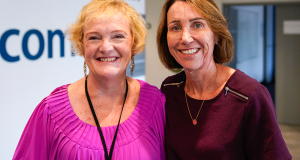
When Australian Capital Reserve was placed in voluntary administration two weeks ago it was the life savings of mum and dad investors, up to $330 million worth, that were at greatest risk.
Real estate agent Sam Pogson and many of the company’s founders are members of the Christadelphian church, pointing again to how vulnerable churches are to a scam known as “Affinity Fraud”.
Professor McGregor Lowndes from The Centre of Philanthropy and Nonprofit Studies at the Queensland University of Technology describes the scenario where the minister introduces a congregation member to a relatively new member who from their appearance is an obviously wealthy, but devout business person.
“You already know this because within a week of joining worship, this person has approached you about a weekly pledge offering and volunteering their services to the property and finance committee,” he said. “Very shortly this person has the church and many of its senior members investing in schemes which have unbelievably high returns.
“What’s more the monthly returns on the investments are actually equal to or exceeding the promises – in cold hard cash.”
Professor McGregor Lowndes said even those who were a bit cautious at first become convinced, investing in the scheme and telling all their friends.
“You can’t believe your blessings, because a percentage of all the investments made by church members is donated to the church by the new member.”
Professor McGregor Lowndes said what happens next is that monthly cheques become delayed and only the very noisy are paid, often with postdated cheques.
“Our new found member then publicly asks for forgiveness from the congregation and explains how the devil has attacked their good works. The person will have to start all over again in business to repay their debts but this won’t happen if the police are involved as the devil would want.”
Pastors and members of the congregation of a Sunshine Coast church found themselves in a similar position. They were some of the investors in a “bank debenture trading program” and another scheme which offered rental rights to caravans.
The perpetrator of the scheme obtained over $190,000 in the period August 1997 to March 1998 on the premise of investing the money into the schemes but instead all the money was put to his own use.
Affinity Fraud is ranked in the top 10 frauds in the United States and has been reported as being Australia’s “most insidious scam”.
The Australian Securities and Investment Commission (ASIC) is also concerned about the rising number of Affinity Fraud cases, particularly in religious communities.
A member of the Beenleigh Uniting Church congregation who serves on the Assembly Legal Reference Committee Professor McGregor Lowndes and his research assistant Zenova Pappas have been investigating the impact of Affinity Fraud on close-knit religious communities.
He says the fraudster works on the relationships and trust they have developed by their involvement in the congregation and persuades someone else like a leader or well respected and trusted member of the group to use their influence to convince people to invest in financial schemes which are only intended to make the fraudster rich and to dupe those who invest.
“This is why the word ‘Affinity’ is used to describe this type of fraud. Members of a group have an affinity to each other because of, for example, shared beliefs and interests, or commonalities in ethnic or religious backgrounds which drew them to that group in the first place.
The fraudsters take advantage of a person’s trust, goodwill and dedication, and the perpetrators often make faith in God synonymous with faith in their investment plan.
“Examples have shown that, where Affinity Fraud has taken place, a vast number of people have been affected.
“In spite of this fact, it is reported that people are often too embarrassed to come forward because they have been conned or feel guilty because they feel that they are also somehow implicated in the scheme.”
Below is a more detailed report on how Affinity Fraud works and how to prevent it. Journey is sincerely grateful to Professor McGregor Lowndes and Ms Pappas for their valuable work.
Can Affinity Fraud manifest in other ways?
Sometimes Affinity Fraud can be promoted within a particular religious or community group not because of any direct involvement or links the perpetrator might have with that group specifically, but because of a particular relationship or role they might have with another similar group which still fosters that affinity.
An example of this was a recent case heard in the Commercial and Consumer Tribunal in Queensland.
This case involved a resale transaction scheme. It was designed to be a ‘deliberately manipulative’ scheme whereby a real estate agent (“the agent”) used several of his companies to take out options to purchase homes at the lower end of the market and then resold them to unsuspecting purchasers who were commercially naive at heavily inflated prices.
In the end the purchasers became indebted to these companies as well as the bank (which was similarly deceived as to the market value of the property) for amounts far in excess of the market value of the properties whilst the agent’s companies (and therefore the agent) generated substantial profits and held the benefit of a second mortgage.
Worse still these purchasers had ‘little or no prospect in servicing those debts.’
The Tribunal found, among other things that, the agent had used his pastoral role within his church to “inspire trust” in purchasers who attended other churches to purchase houses at highly inflated prices: ‘…the evidence clearly shows that the subject of the agent’s church role was used to inspire trust’ and ‘it is immaterial what sect or denomination the purchasers belonged to, because their religious beliefs influenced them to trust people who played a pastoral role with a church.’.
What sort of schemes make up Affinity Fraud?
The most commonly used investment scheme is the “ponzi” or pyramid schemes. The Direct Selling Education Foundation defines pyramid schemes as:
“…illegal scams in which large numbers of people at the bottom of the pyramid pay money to a few people at the top. Each new participant pays for the chance to advance to the top and profit from payments of others who might join later….
“Of course, the pyramid may collapse long before you reach the top. In order for everyone in a pyramid scheme to profit, there would have to be a never-ending supply of new participants.
“In reality, however, the supply of participants is limited, and each new level of participants has less chance of recruiting others and a greater chance of losing money.”
Preventing Affinity Fraud
ASIC has targeted its information towards potential victims. It sees that the best method to stop or at least curb the occurrences of Affinity Fraud is to encourage individuals to be more wary about investments schemes being touted at their church and if desirous of investing, that individuals do their homework first.
They are also encouraging people to notify ASIC on suspicion that their church or relevant group is being used to promote Affinity Fraud schemes.
However, it is worth suggesting that senior church leaders and members of church boards can most certainly play a valuable role in preventing the fraud and protecting their members through such things as education or regulation.
Church administrators and treasurers should carefully vet all proposals which involve using the organisation’s name, reputation or senior church figure heads to endorse or promote any undertaking, business venture or investment.
This vetting requires that before any proposal is endorsed that proper checks are made of the legality, financial soundness and background of parties involved.
The mere fact that the church also receives some financial compensation from the deal should not unduly influence the vetting of the proposal.
Particular attention should be paid to those who have conflict of interest in the proposals approved.
Websites of Interest
For more information, let your fingers do the walking!
The U.S Securities and Exchange Commission gives a good summary of Affinity Fraud http://www.sec.gov/investor/pubs/affinity.htm
So too the North American Securities Administrators Association http://www.nasaa.org/Investor_Education/Investor_Alerts___Tips/1679.cfm
To see the Australian responses check out ASIC/FIDO http://www.asic.gov.au/fido/fido.nsf/print/affinity+fraud+can+it+happen+to+you?opendocument
ASIC also has information about pyramid schemes http://www.fido.asic.gov.au/fido/fido.nsf/byheadline/Pyramid+schemes?openDocument
For more information
The Centre of Philanthropy and Nonprofit Studies at the Queensland University of Technology is currently conducting research into Affinity Fraud and its growth in Australia.
If you are keen to remain updated about their research, please contact the Centre on HERE indicating your interest.
 JourneyOnline
JourneyOnline






